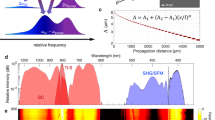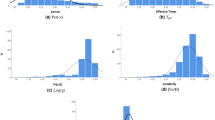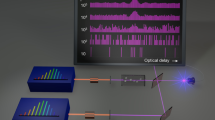Abstract
Finding an Earth–Sun analogue is one of the longest-standing goals in astronomy. The detection of such a system using the radial velocity (RV) technique is highly challenging, and would require coordinated advances in astronomical telescopes, fibre optics, precision spectrographs, large-format detector arrays and data processing. Measurements at the necessary 10−10 level over multiyear periods would also require a highly precise calibrator. Here we explore simple and robust white-light-illuminated Fabry–Pérot (FP) etalons as spectral calibrators for precise RV measurements. We track the frequencies of up to 13,000 FP modes against laser frequency combs at two state-of-the-art spectrographs and trace unexpected chromatic variations of the modes to subpicometre changes in the dielectric layers of the broad-bandwidth FP mirrors, corresponding to a RV precision at the centimetres per second level. These results represent critical progress in precision RV measurements in two ways—they validate FP etalons as a more powerful stand-alone calibration tool and demonstrate the capability of laser frequency combs to extend RV measurement precision at the centimetres per second level over periods approaching a year. These advances highlight a path to achieving spectroscopic calibration at levels that will be critical for finding Earths like our own.
This is a preview of subscription content, access via your institution
Access options
Access Nature and 54 other Nature Portfolio journals
Get Nature+, our best-value online-access subscription
$32.99 / 30 days
cancel any time
Subscribe to this journal
Receive 12 digital issues and online access to articles
$119.00 per year
only $9.92 per issue
Buy this article
- Purchase on SpringerLink
- Instant access to full article PDF
Prices may be subject to local taxes which are calculated during checkout



Similar content being viewed by others
Data availability
All data needed to reproduce the results of this Article are available at https://scholar.colorado.edu/concern/datasets/m326m3334 (ref. 51).
References
Lovis, C. et al. Radial velocity techniques for exoplanets. In Exoplanets (ed. Seager, S.) 27–53 (University of Arizona Press, 2010).
Palle, E. et al. Ground-breaking exoplanet science with the ANDES spectrograph at the ELT. Preprint at https://arxiv.org/abs/2311.17075 (2023).
Fischer, D. A. et al. State of the field: extreme precision radial velocities. Publ. Astron. Soc. Pacif. 128, 066001 (2016).
Wang, S. X. et al. Characterizing and mitigating the impact of telluric absorption in precise radial velocities. Astron. J. 164, 211 (2022).
Vanderburg, A. et al. Radial velocity planet detection biases at the stellar rotational period. Mon. Not. R. Astron. Soc. 459, 3565–3573 (2016).
Mahadevan, S. et al. The Habitable-zone Planet Finder: a stabilized fiber-fed NIR Spectrograph for the Hobby-Eberly Telescope. Proc. SPIE 8446, 84461S (2012).
Diddams, S. A., Vahala, K. & Udem, T. Optical frequency combs: coherently uniting the electromagnetic spectrum. Science 369, eaay3676 (2020).
Murphy, M. T. et al. High-precision wavelength calibration of astronomical spectrographs with laser frequency combs. Mon. Not. R. Astron. Soc. 380, 839–847 (2007).
McCracken, R. A., Charsley, J. M. & Reid, D. T. A decade of astrocombs: recent advances in frequency combs for astronomy [invited]. Opt. Express 25, 15058–15078 (2017).
Metcalf, A. J. et al. Stellar spectroscopy in the near-infrared with a laser frequency comb. Optica 6, 233–239 (2019).
Probst, R. A. et al. A crucial test for astronomical spectrograph calibration with frequency combs. Nat. Astron. 4, 603–608 (2020).
Buisson, H., Fabry, C. & Bourget, H. An application of interference to the the study of the Orion Nebula. Astrophys. J. 40, 241–258 (1914).
Schmidt, T. M. et al. Fundamental physics with ESPRESSO: towards an accurate wavelength calibration for a precision test of the fine-structure constant. Astron. Astrophys. 646, A144 (2021).
Terrien, R. C. et al. Broadband stability of the Habitable Zone Planet Finder Fabry-Pérot etalon calibration system: evidence for chromatic variation. Astron. J. 161, 252 (2021).
Halverson, S. et al. Development of fiber Fabry-Perot interferometers as stable near-infrared calibration sources for high resolution spectrographs. Publ. Astron. Soc. Pacif. 126, 445 (2014).
Schäfer, S. et al. Two Fabry-Pérots and two calibration units for CARMENES. Proc. SPIE 10702, 1070276 (2018).
Schmidt, T. M. et al. Chromatic drift of the espresso Fabry-Pérot etalon. Astron. Astrophys. 664, A191 (2022).
Wildi, F., Pepe, F., Chazelas, B., Curto, G. L. & Lovis, C. A Fabry-Perot calibrator of the HARPS radial velocity spectrograph: performance report. Proc. SPIE 7735, 77354X (2010).
Gibson, S. R. et al. Keck Planet Finder: design updates. Proc. SPIE 11447, 1144742 (2020).
Stürmer, J. et al. A rubidium traced white-light etalon calibrator for MAROON-X. Proc. SPIE 9912, 991229 (2016).
Schwab, C. et al. Design of NEID, an extreme precision Doppler spectrograph for WIYN. Proc. SPIE 9908, 99087H (2016).
Grieves, N. et al. NIRPS: the Near-InfraRed Planet Searcher joining HARPS on the 3.6-m. In European Planetary Science Congress 2021 EPSC2021-555 (Europlanet Science Congress, 2021).
Cersullo, F., Wildi, François, Chazelas, B. & Pepe, F. A new infrared Fabry-Pérot-based radial-velocity-reference module for the spirou radial-velocity spectrograph. Astron. Astrophys. 601, A102 (2017).
Crepp, J. R. et al. iLocater: a diffraction-limited Doppler spectrometer for the Large Binocular Telescope. Proc. SPIE 9908, 990819 (2016).
Szentgyorgyi, A. et al. G@M: design of the Giant Magellan Telescope Consortium Large Earth Finder (G-CLEF) for operations at the Magellan telescopes. Proc. SPIE 12184, 121841N (SPIE, 2022).
Martin, M. J. & Ye, J. in Optical Coatings and Thermal Noise in Precision Measurement (eds Harry, G. M. et al.) 237–258 (Cambridge University Press, 2012).
Storz, R., Braxmaier, C., Jäck, K., Pradl, O. & Schiller, S. Ultrahigh long-term dimensional stability of a sapphire cryogenic optical resonator. Opt. Lett. 23, 1031–1033 (1998).
Robinson, J. M. et al. Crystalline optical cavity at 4 K with thermal-noise-limited instability and ultralow drift. Optica 6, 240–243 (2019).
Alnis, J., Matveev, A., Kolachevsky, N., Udem, T. & Hänsch, T. W. Subhertz linewidth diode lasers by stabilization to vibrationally and thermally compensated ultralow-expansion glass Fabry-Pérot cavities. Phys. Rev. A 77, 053809 (2008).
Hirata, S., Akatsuka, T., Ohtake, Y. & Morinaga, A. Sub-hertz-linewidth diode laser stabilized to an ultralow-drift high-finesse optical cavity. Appl. Phys. Express 7, 022705 (2014).
Ito, I., Silva, A., Nakamura, T. & Kobayashi, Y. Stable CW laser based on low thermal expansion ceramic cavity with 4.9 mHz/s frequency drift. Opt. Express 25, 26020–26028 (2017).
Schwab, C. et al. Stabilizing a Fabry-Pérot etalon peak to 3 cm s for spectrograph calibration. Publ. Astron. Soc. Pacif. 127, 880–889 (2015).
Betters, C. H., Leon-Saval, S. G. & Bland-Hawthorn, J. Photonic comb: a stabilized single-mode fiber etalon for wavelength calibration. Appl. Opt. 63, D14–D20 (2024).
Tang, L. et al. Drift performance and chromatic thermal response of a temperature stabilized solid-etalon calibrator. Astron. J. 165, 156 (2023).
Berthold, J. W., Jacobs, S. F. & Norton, M. A. Dimensional stability of fused silica, invar, and several ultra-low thermal expansion materials. Metrologia 13, 9–16 (1977).
Hils, D., Hall, J. L. & De Marchi, A. in Frequency Standards and Metrology (ed. De Marchi, A.) 162–173 (Springer, 1989).
Jennings, J. et al. Frequency stability of the mode spectrum of broad bandwidth Fabry-Pérot interferometers. OSA Contin. 3, 1177–1193 (2020).
Hill, I. R. et al. Dual-axis cubic cavity for drift-compensated multi-wavelength laser stabilisation. Opt. Express 29, 36758–36768 (2021).
Wang, S. et al. Integrated multiple wavelength stabilization on a multi-channel cavity for a transportable optical clock. Opt. Express 28, 11852–11860 (2020).
Milani, G. et al. Multiple wavelength stabilization on a single optical cavity using the offset sideband locking technique. Opt. Lett. 42, 1970–1973 (2017).
Arias, N., González, L. J., Abediyeh, V. & Gomez, E. Frequency locking of multiple lasers to an optical cavity. J. Opt. Soc. Am. B 35, 2394–2398 (2018).
Dawel, F. et al. Coherent photo-thermal noise cancellation in a dual-wavelength optical cavity for narrow-linewidth laser frequency stabilisation. Opt. Express 32, 7276–7288 (2024).
Berthold, J. Dimensionality Stability of Low Expansion Materials – Time Dependent Changes in Optical Contact Interfaces and Phase Shifts on Reflection from Multilayer Dielectrics. PhD thesis, Univ. Arizona (1976).
Kreider, M. K., Rehan, A. Q., Kent, R. M., Bezerra, A. T. & Rebello Sousa Dias, M. Al-Au thin films for thermally stable and highly sensitive plasmonic sensors. J. Phys. Chem. C 126, 5628–5639 (2022).
Burnett, D. The relation between refractive index and density. Math. Proc. Camb. Phil. Soc. 23, 907–911 (1927).
Abadias, G. & Guerin, P. In situ stress evolution during magnetron sputtering of transition metal nitride thin films. Appl. Phys. Lett. 93, 111908 (2008).
Mahadevan, S. et al. The Habitable-zone Planet Finder: a status update on the development of a stabilized fiber-fed near-infrared spectrograph for the for the Hobby-Eberly telescope. Proc. SPIE 9147, 91471G (2014).
Halverson, S. et al. A comprehensive radial velocity error budget for next generation Doppler spectrometers. Proc. SPIE 9908, 99086P (2016).
Robertson, P. et al. Ultrastable environment control for the NEID spectrometer: design and performance demonstration. J. Astron. Telesc. Instrum. Syst. 5, 015003 (2019).
NEID Specsoft Team NEID Data Reduction Pipeline: NEID-DRP (NEID, 2024); https://neid.ipac.caltech.edu/docs/NEID-DRP
Kreider, M. K. et al. Quantifying broadband chromatic drifts in Fabry-Perot resonators for exoplanet science. CU Scholar https://scholar.colorado.edu/concern/datasets/m326m3334 (2024).
Acknowledgements
We acknowledge helpful discussions with J. Stürmer on mirror coatings, who has also pointed out the importance of relaxation of the stress in the outer dielectric coating layers and its impact on the variation of the mirror properties. We also acknowledge useful technical conversations with M. Rebello de Sousa Dias about optical modelling and material properties. We are grateful for financial support from NIST award number 70NANB18H006 from the US Department of Commerce (C.F.) and from NSF grant numbers AAG 2108512 (S.M.), ATI 2009889 (S.M.), ATI 2009982 (S.A.D.), ATI 2009955 (R.C.T.), AST 1310875 (S.A.D.) and AST 1310885 (S.M.). NEID DRP development is supported by JPL Subcontract 1644767 (C.F.B.). M.K.K. acknowledges support from the NSF Graduate Research Fellowship Program. The Hobby–Eberly Telescope (HET) is a joint project of the University of Texas at Austin, the Pennsylvania State University, Ludwig-Maximilians-Universität München and Georg-August-Universität Göttingen. The HET is named in honour of its principal benefactors, William P. Hobby and Robert E. Eberly. The Center for Exoplanets and Habitable Worlds and the Penn State Extraterrestrial Intelligence Center are supported by Penn State and its Eberly College of Science.
Author information
Authors and Affiliations
Contributions
R.C.T., S.M., J.P.N., S.H., C.F.B., F.H., J.R., A.R., C.S. and J.T.W. built the NEID and HPF instruments and acquired the etalon drift data. M.K.K., C.F. and S.A.D. developed the model to explain the etalon drift. M.K.K., C.F., S.A.D., R.C.T. and S.M. analysed the data and wrote the initial draft of the paper. D.M. provided information on the mirror coating structure and advised on drift sources. All authors discussed the results and contributed to revising and editing the final paper.
Corresponding authors
Ethics declarations
Competing interests
The authors declare no competing interests.
Peer review
Peer review information
Nature Astronomy thanks Alexandre Cabral and Fei Zhao for their contribution to the peer review of this work.
Additional information
Publisher’s note Springer Nature remains neutral with regard to jurisdictional claims in published maps and institutional affiliations.
Supplementary information
Supplementary Information
Supplementary Figs. 1–5 and Notes 1–4.
Rights and permissions
Springer Nature or its licensor (e.g. a society or other partner) holds exclusive rights to this article under a publishing agreement with the author(s) or other rightsholder(s); author self-archiving of the accepted manuscript version of this article is solely governed by the terms of such publishing agreement and applicable law.
About this article
Cite this article
Kreider, M.K., Fredrick, C., Diddams, S.A. et al. Quantification of broadband chromatic drifts in Fabry–Pérot resonators for exoplanet science. Nat Astron 9, 589–597 (2025). https://doi.org/10.1038/s41550-025-02486-x
Received:
Accepted:
Published:
Issue date:
DOI: https://doi.org/10.1038/s41550-025-02486-x
This article is cited by
-
Quantification of broadband chromatic drifts in Fabry–Pérot resonators for exoplanet science
Nature Astronomy (2025)



